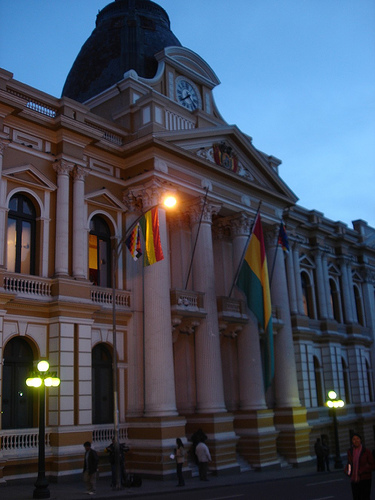
Photo taken by Patricia Vargas Claudio and used with permission.
National symbols played a role in the presidential elections of December 2005. Jorge “Tuto” Quiroga, the main rival to the eventual winner, Evo Morales, accused his opponent of wanting to change the traditional red, yellow, and green flag to something that reflected the indigenous pride that Morales campaigned on. The wiphala, a multi-colored checkered flag used by indigenous peoples, had figured prominently in the campaign and rallies of the eventual winner. Quiroga and his PODEMOS party said that such a flag would not include those Bolivians that did not identify themselves as indigenous and that the existing tri-color flag was the only symbol that could represent multicultural Bolivia. However, Morales and the rest of his MAS party denied any desire to change the flag.
Little by little the wiphala made its appearance in many official locations, such as in the corner of powerpoint slides in the presentation by a cabinet minister during a conference attended by blogger Willy Andres . Plan B’s Sebastian Molina noticed something peculiar about the look of the state-run television channel’s logo. The logo with three triangles with the red, yellow and green was gone and replaced with a nine-square logo that resembled the wiphala. The official government version is that the nine-square logo represents the nine departments of Bolivia, but to Willy Andres it is obvious what it most resembles. However, there has been legislation in Congress to make the wiphala a patriotic symbol, but there is a contradiction as noted by Molina.
En esas contradicciones que tiene la vida política de este país, me encontré con la perlita de que efectivamente ya se había discutido en el parlamento la posibilidad de incluirla como símbolo patrio. Pero… ¿adivinen quién lo propuso? Nada más y nada menos que PODEMOS, mediante su diputado Rodrigo Paz Pereira. Obviamente el debate se quedó en propuesta nomás y no pasó a concretarse.
A ver, recapitulando… El M.A.S. introduce la whipala como símbolo “nacional” en el canal oficial. Pero no acepta que desea colocarla como símbolo patrio. ¿Qué hace entonces la whipala colgada fuera del palacio de gobierno? ¿Están siendo sinceros con la ciudadanía? PODEMOS “denuncia” que el M.A.S. quiere introducir la whipala como símbolo patrio. Anuncia una “batalla por la bolivianidad y la defensa de la tricolor”. Pero luego propone en el parlamento nacional que la whipala pase a ser símbolo patrio. ¿En qué quedamos? ¿Están siendo sinceros con la ciudadanía
To recap… MAS introduces the wiphala as a “national” symbol in the official channel, but does not accept to make it a patriotic symbol. Then, why does the wiphala hang outside the presidential palace? Are they being sincere with the population? PODEMOS “denounces” that MAS wants to introduce the wiphala as a patriotic symbol and announces a “fight for the bolivianity and the defnese of the tri-color.” Later in parliament they propose that the wiphala should become a nationally symbol. Where do we sit? Are they being sincere with the population?
Pictures that Molina referred to of the wiphala flying outside of the presidencial palace was taken by blogger Patricia Vargas Claudio of Arquitecta.
RODRIGO GONZALEZ FERNANDEZ
CONSULTAJURIDICACHILE.BLOGSPOT.COM
Renato Sánchez 3586 dep 10
Santiago, Chile
No hay comentarios.:
Publicar un comentario